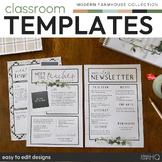19 results
Social emotional learning cultural activities for Google Apps and for staff
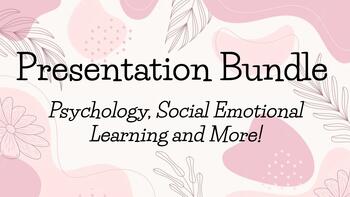
Psychology/SEL Presentations Bundle
This bundle includes a total of 6 PPT at a discounted rate!Presentations included:-16 Personalities Workshop-Family Dynamics-Maslow's Hierarchy of Needs-Perception-Power, Control, and Authority-You & Your Brain
Grades:
9th - 12th, Higher Education, Adult Education, Staff
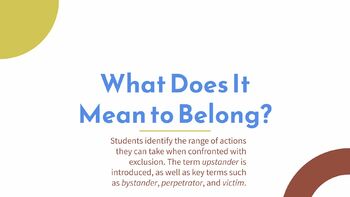
What Does It Mean to Belong?
This lesson is part 9/10 of the unit Identity & Community<<<(LINKED HERE)However, this lesson can be given as a stand-alone assignment.Students identify the range of actions they can take when confronted with exclusion. The term upstander is introduced, as well as key terms such as bystander, perpetrator, and victim.In Lesson 8, students explored issues of membership and belonging through a fictional and historical example. “The ‘In’ Group,” a short reading included in this lesson,
Grades:
K - 12th, Higher Education, Adult Education, Staff
Also included in: Identity & Community: 10 Lesson Unit
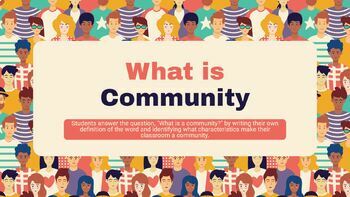
What is Community?
This lesson is part 6/10 of the unit Identity & Community<<<(LINKED HERE)However, this lesson can be given as a stand-alone assignment.Students answer the question, "What is a community?" by writing their own definition of the word and identifying what characteristics make their classroom a community.With Lesson 6, students move away from the study of individuals to the study of groups of people. Communities are distinguished from groups by the fact that they share a common interest
Grades:
K - 12th, Higher Education, Adult Education, Staff
Also included in: Identity & Community: 10 Lesson Unit

Who Am I?
This lesson is part 1/10 of the unit Identity & Community<<<(LINKED HERE)However, this lesson can be given as a stand-alone assignment.By asking the question “Who am I?” students explore the role that identity plays in forming their values, ideas and actions. “Who am I?” is a question we all ask at some time in our lives. It is an especially critical question for adolescents. As we search for answers we begin to define ourselves. How is our identity formed? To what extent are we def
Grades:
K - 12th, Higher Education, Adult Education, Staff
Also included in: Identity & Community: 10 Lesson Unit
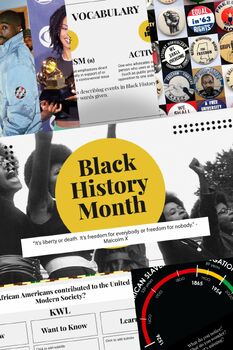
Black History Month | Black Culture Appreciation - 11 Lessons + more!
Hello Educator,The intent behind creating this resource was to teach Black History and Culture in such a way that it celebrates, honors, and develops a proper form of reverence for the sacrifices and contributions of African Americans that have benefited our society. This was a labor of love.With this purchase you will receive: 11 mini lessonsIntroBlack History In America Timeline Civil Rights: DesegregationCivil Rights: VotingCivil RIghts: Black Power MovementMartin V. MalcolmBreaking the Color
Grades:
8th - 12th, Staff
Types:
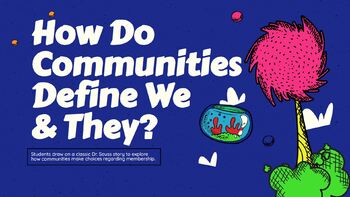
How Do Communities Define We & They?
This lesson is part 8/10 of the unit Identity & Community<<<(LINKED HERE)However, this lesson can be given as a stand-alone assignment.Students draw on a classic Dr. Seuss story to explore how communities make choices regarding membership.Communities are made up of distinct groups of people such as students, business people, musicians, and city employees. At the same time, communities are situated within a larger network of places such as other cities in your state or the United Sta
Grades:
K - 12th, Higher Education, Adult Education, Staff
Also included in: Identity & Community: 10 Lesson Unit

Mood Check in Famous Black Women
This set includes 6 Mood Boards with Black Women Representation including, Oprah, Viola Davis, Michelle Obama, Gabrielle Union, Kerry Washington, and Serena Williams. Each board is on a google slide that you can copy and paste into your own slides. These mood boards are a great way to do a quick SEL Check in and is a great way to tie in some Black Women Herstory all year long! Students love to see representation of themselves and the effort goes a long way!
Subjects:
Grades:
6th - 12th, Staff

What Makes ________ a Community?
This lesson is part 7/10 of the unit Identity & Community<<<(LINKED HERE)However, this lesson can be given as a stand-alone assignment.Students connect what they have learned about communities to their knowledge of (Insert City), by analyzing images of historical and local importance to the city.Following Lesson 6, students should have a conceptual understanding of the term community. In this lesson, students explore the meaning of community in a more concrete way. Through describin
Grades:
K - 12th, Higher Education, Adult Education, Staff
Also included in: Identity & Community: 10 Lesson Unit
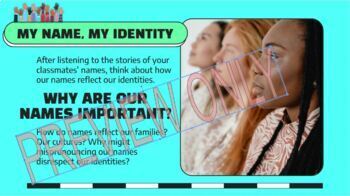
Say My Name: The Importance of Name Pronunciation
One of the most daunting aspects of the first days of school can be learning students' names, and our names are central parts of our identities. These three lessons and the project help you learn how to pronounce your students' names and empower your students to expect the respect of proper pronunciation. What you will get:Step-by-step lesson plans with all of the necessary links to presentations, handouts, and any media needed.A 26-slide Google Slides presentation that spans three lessons with
Grades:
6th - 12th, Higher Education, Adult Education, Staff
Types:
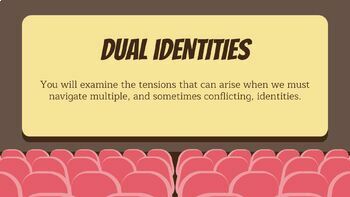
Dual Identities
Students will examine the tensions that can arise when we must navigate multiple, and sometimes conflicting, identities.In this activity, students will read a poem written by a student who is reflecting on the relationship between his name and his dual identity. While the majority of the poem is in English, some phrases are written in Spanish. Think about how you would like your group to read the poem.
Grades:
PreK - 12th, Higher Education, Adult Education, Staff
Also included in: Exploring Your Identity
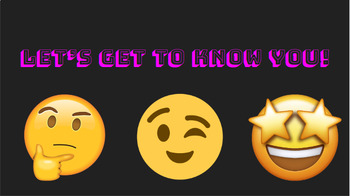
Get to Know You Game- NO PREP Required!
This product that is a simple get to know you game that will work from ages K-12th grade. It's great for the beginning of the year, for a class needing a refresher get to know you game, to keep things fresh after a break, or a class simply needing a break! It's a simple game which asks students to stand up if the sentence applies to them, but to stay seated if it does not apply to them. Fun for teachers to join in too!
Grades:
K - 12th, Adult Education, Staff

What Aspects of Our Identities Do We Show Others?
This lesson is part 4/10 of the unit Identity & Community<<<(LINKED HERE)However, this lesson can be given as a stand-alone assignment.Through a mask-making activity, students learn that they can conceal or reveal aspects of their identity.In previous lessons, students have focused on various factors that shape our identities. They have learned that our answer to the question “Who am I?” is influenced by biographical characteristics and personal experiences. We define ourselves. At
Grades:
K - 12th, Higher Education, Adult Education, Staff
Also included in: Identity & Community: 10 Lesson Unit

What Shapes Your Identity?
This lesson is part 2/10 of the unit Identity & Community<<<(LINKED HERE)However, these lessons can be given individually.Through a poem writing activity, students broaden and deepen their understanding of identityThe previous lesson introduced students to the term identity and encouraged them to think about the factors that shape their own identity. This lesson includes activities to deepen and broaden students’ ideas about identities. First, students share their identity charts as
Grades:
K - 12th, Higher Education, Adult Education, Staff
Also included in: Identity & Community: 10 Lesson Unit
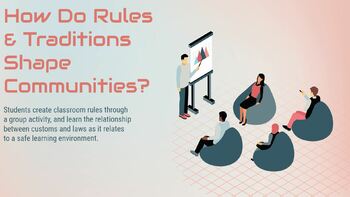
How Do Rules & Traditions Shape Communities?
This lesson is part 10/10. the final lesson, of the unit Identity & Community<<<(LINKED HERE)However, this lesson can be given as a stand-alone assignment.In Lesson 6, students analyzed Suzanne Goldsmith’s definition of community. Goldsmith explains that a group of people become a community when they have a shared goal. A class is a community of learners: The shared goal, or “common enterprise,” is the intellectual, moral, and social development of students. In Lesson 7 students loo
Grades:
K - 12th, Higher Education, Adult Education, Staff
Also included in: Identity & Community: 10 Lesson Unit
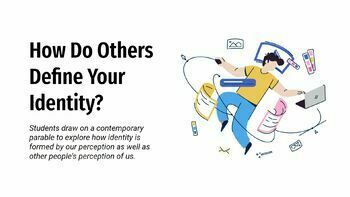
How Do Others Define Your Identity?
This lesson is part 3/10 of the unit Identity & Community<<<(LINKED HERE)However, this lesson can be given as a stand-alone assignment.Students draw on a contemporary parable to explore how identity is formed by our perception as well as other people's perception of us.In the first two lessons, students engaged in activities in which they answered the question, “Who am I?” Yet, even as we struggle to define our unique identity, we are being defined by others. Sometimes groups attach
Grades:
K - 12th, Higher Education, Adult Education, Staff
Also included in: Identity & Community: 10 Lesson Unit
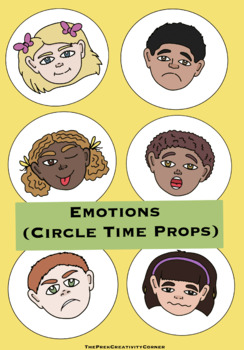
Emotions (Circle Time Props)
A Set of 6 Emotions1.) Happy2.) Sad3.) Surprised4.) Nervous5.) Angry6.) Silly Important Information: Instant Digital Download. No actual product will be shipped to you. Once you purchase the digital item it will be ready to download, print, and save forever. It’s a really easy process! If you’re looking for a specific size with any of my digital downloads feel free to message me your concerns. You can print as many times as you like, cut them, and for your classroom. Fast, easy, and affordable.
Grades:
PreK - 3rd, Staff
Also included in: Circle Time Resources Bundle + Bonus Surprise!
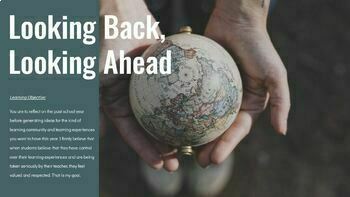
Looking Ahead
Students are to reflect on the past school year before generating ideas for the kind of learning community and learning experiences you want to have this year. I firmly believe that when students believe that they have control over their learning experiences and are being taken seriously by their teacher, they feel valued and respected. This should be all of our shared goal.
Grades:
PreK - 12th, Higher Education, Adult Education, Staff
Also included in: Exploring Your Identity
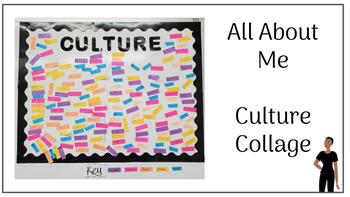
All About Me - Culture Collage - Back to School
This product can be used to help build class community because it gives every student a voice and a chance to share unique things about his/her culture. Students will have a chance to work alone and then share their responses with their peers. Finally, the results will be displayed in the classroom on a bulletin board. This resource contains a link to a Google Slides version.
Grades:
3rd - 12th, Higher Education, Adult Education, Staff
Also included in: All About Me Bundle - Back to School
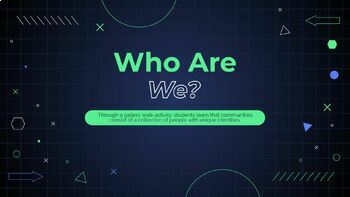
Who Are We?
This lesson is part 5/10 of the unit Identity & Community<<<(LINKED HERE)However, this lesson can be given as a stand-alone assignment.Through a gallery walk activity, students learn that communities consist of a collection of people with unique identities.Typically, a study of history focuses on the identities of groups—cultures, communities, and civilizations—more than on the identities of particular individuals. Yet the same factors that influence the identities of individuals in
Grades:
K - 12th, Higher Education, Adult Education, Staff
Also included in: Identity & Community: 10 Lesson Unit
Showing 1-19 of 19 results

